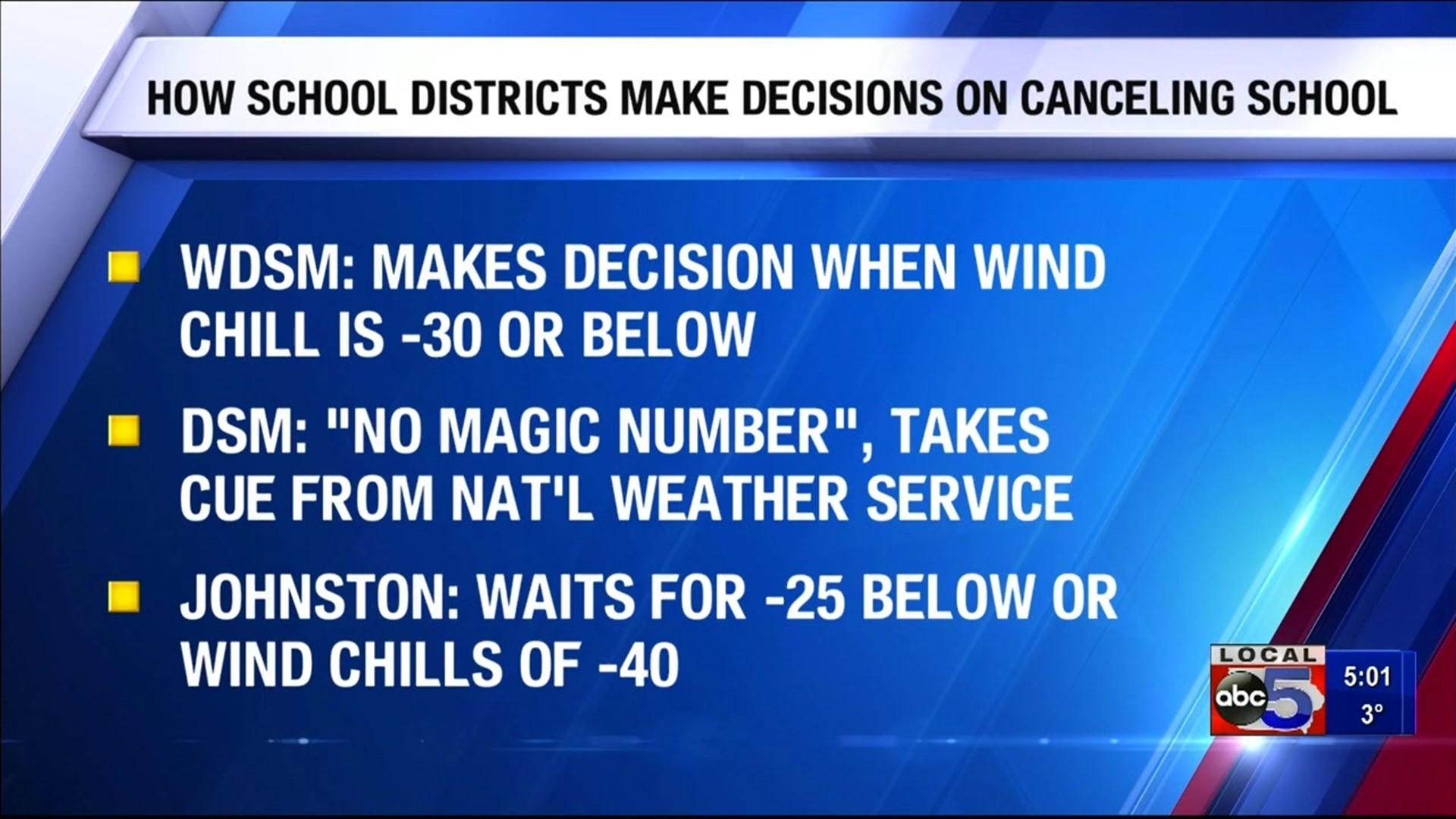With temperatures plummeting below zero for hours, some schools across central Iowa delayed or canceled classes because of the frigid weather.
But not every district closed for the day, and many Iowans want to know what factors play into district officials canceling for the day. Local 5 On Your Side asked around the districts and gathered information.
West Des Moines
“Our typical gauge is if the wind chill is -30 or below, we will have a two-hour late start,” said West Des Moines School officials. “We also look to see at what time that temperature would rise above that mark. If it doesn’t look like the wind chill would be above -30 to fit within that two-hour window, we may choose to cancel school.”
Des Moines
“Generally, if the NWS issues a warning, whether for wind chill or a winter storm, that will mean we’re looking very closely at a cancellation, early dismissal, or delayed start,” said Phil Roeder with DMPS. “However, there is not a magic number that automatically triggers a decision. It also depends on what the actual conditions are as well as the projected timing of the storm.”
Johnston
“For cold and frigid temperatures, we try our best to make a decision the evening before. If the National Weather Service forecast for 6 a.m. calls for air temperatures of 25 degrees below zero or colder, or if the forecast wind chill is minus 40 or worse, classes and activities may be canceled. If this threshold is not met, we will to continue to monitor conditions and make any needed decisions into the next morning.”
Waukee
The decision is normally made by the superintendent no later than 5:30 a.m. School officials consider a number of factors, including the safety of the students, the safety of staff members, timing of the event, the current state of road conditions, the type and duration of a weather advisory/warning, and consultation with Des Moines and other neighboring school systems.
Ames
“The safety of students, staff, and parents is a priority when making these decisions. We take into consideration travel conditions, as well as students who may have to walk and/or wait for the bus.” Some of those factors include:
- Timing of impending winter storm
- Travel conditions that includes blowing and drifting snow.
- Wind chill threshold as determined by the National Weather Service. We use a fifteen-minute threshold as a gauge when making decisions.
Ankeny
“Our first and foremost consideration is the safety of our students and staff. We take a number of steps to ensure they have a safe trip to and from school.” Many factors go into the determination of whether to hold school:
- Monitoring Current Conditions & Forecasts – Prior to a storm, district personnel monitor forecasts and live radar images to help determine if a weather system is likely to impact the current conditions. For example: If there is six inches of “powder” snow on the ground and the forecast is for high winds, this could cause visibility problems. If the road is slushy, but temperatures are forecast to drop quickly and drastically, this could be a factor.
- Personnel on the Street – District personnel take to the streets to determine the actual conditions in the district. If a storm is at night or predicted for the morning, Support Services personnel begin monitoring actual conditions between 2:30 and 3:00 am, and continue throughout the early morning hours. District personnel also clear lots and sidewalks, and sand and salt as necessary.
- Ability to Clear Pathways – We take into consideration whether we will be able to clear school sidewalks and parking lots – is there too much snow to clear in a timely fashion, or is snow continuing to accumulate at a rate in which it cannot be cleared adequately?
- Monitoring Temperature – We take into account the temperature and wind chill, both to determine air temperature safety, but also to determine the possibility of changing road conditions.
- Visibility – Visibility is monitored; if blowing snow causes poor visibility this could be a factor in cancellation.
- Coordination of Sources – All of these factors are taken into consideration and a decision is made through communication and data input from many sources. In addition, the district coordinates with city staff and police regarding any decision that is made.

